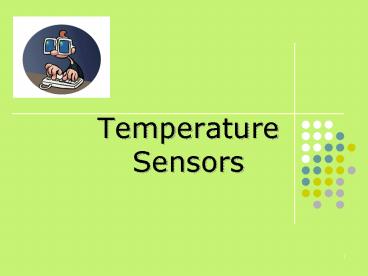Temperature Sensors PowerPoint PPT Presentation
1 / 15
Title: Temperature Sensors
1
Temperature Sensors
2
Warm-ups
3
Objectives
- At the end of this chapter, the students should
be able to - describe the principle of operation of various
sensors and transducers namely.. - Resistance Temperature Detectors.
- Thermocouples
- Thermistors
- Photodiode
- Phototransistors
4
Temperature Transducers
- The temperature transducers can be divided into
four main categories - Resistance Temperature Detectors (RTD)
- Thermocouples
- Thermistors
- Ultrasonic transducers
5
Resistance Temperature Detectors (RTDs)
- Detectors of resistance temperatures commonly
employ platinum, nickel, or resistance wire
elements, whose resistance variation with
temperature has a high intrinsic accuracy. - They available in many configurations and sizes
and as shielded and open units for both immersion
and surface applications.
6
Resistance Temperature Detectors (RTDs)
- Some examples of RTDs are as follows
7
Resistance Temperature Detectors (RTDs)
- The relationship between temperature and
resistance of conductors can be calculated from
this equation - where
- R resistance of the conductor at temp t (oC)
- Roresistance at the reference temp.
- temperature coefficient of resistance
- ? difference between operating and reference
temp.
8
Resistance Temperature Detectors (RTDs)
Example A platinum resistance thermometer has a
resistance of 220? at 20oC. Calculate the
resistance at 50oC? Given that
?20oC0.00392.
9
Thermocouples
- A thermocouple is a sensor for measuring
temperature. It consists of two dissimilar /
different metals, joined together at one end,
which produce a small unique voltage at a given
temperature. This voltage is measured and
interpreted by the thermocouple. - The magnitude of this voltage depends on the
materials used for the wires and the amount of
temperatures difference between the joined end
and the other ends.
10
Thermocouples
- Some examples of the thermocouples are as
follows
11
Thermocouples
- Common commercially available thermocouples are
specified by ISA (Instrument Society of America)
types. - Type E, J, K, and T are base-metal thermocouples
and can be used up to about 1000C (1832F). - Type S, R, and B are noble-metal thermocouples
and can be used up to about 2000C (3632F).
12
Thermocouples
- The following table provides a summary of basic
thermocouple properties.
13
Thermocouples
- Calibration curves for several commercially
available thermocouples is as below
14
Thermocouples
- The magnitude of thermal emf depends on the wire
materials used and on the temperature difference
between the junctions. - The effective emf of the thermocouple is given
as - Where
- c and k constant of the thermocouple materials
- T1 - temperature of the hot junction.
- T2 - temperature of the cold or
reference junction.
15
Thermocouples
Example During experiment with a copper-
costantan thermocouple, it was found that c
3.75x10-2 mV/oC and k 4.50x10-5 mV/oC. If T1
100oC and the cold junction T2 is kept in the
ice, compute the resultant electromotive force,
emf?

